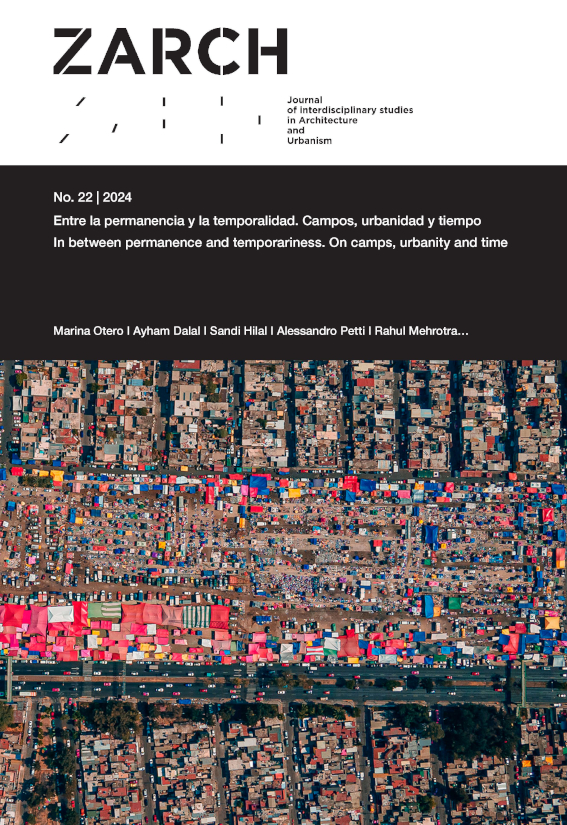Achitecture in exile. Three artistic perspectives on Palestinian refugee camps
DOI:
https://doi.org/10.26754/ojs_zarch/zarch.2024229895Keywords:
Refugee camp, Palestine, Art, Space, Time, BelongingAbstract
This article introduces three artistic projects focused on various spatial, temporal, and habitational dimensions of Palestinian refugee camps. Conceived by Sandi Hilal and Alessandro Petti in collaboration with the residents of Dheisheh camp in Bethlehem, The Concrete Tent embodies a materialization of the enduring temporality that permeates the camps. Following her involvement in the reconstruction of the dismantled Nahr el-Bared refugee camp in Lebanon, Saba Innab explores in How to Build Without a Land constructive responses to inhabiting practices born out of displacement. Lastly, in the Future Cities series Wafa Hourani critically examines the present and, through three models, envisions possible futures for the Qalandia refugee camp in the West Bank. All three projects both highlight and condemn the enduring temporality that characterizes Palestinian refugee camps today, offering insights into the history, present and potential future of these spaces. In addition, the works also affirm the material value of the camp and the active role of its inhabitants in shaping territorial practices and belongings that challenge more normative ones, while deploying alternative imaginaries, narratives, and meanings of time and place.
Downloads
References
“Architectural Models & the Refugee Camp: Alessandro Petti, Wafa Hourani, Stephan Mörsch & Aya Musmar”. Conferencia presentada online co-organizada por Architecture Foundation y The Mosaic Rooms, 24 de noviembre de 2021: https://www.youtube.com/watch?v=krsM4f5toq0 (Consultada el 8 de octubre de 2023).
“Station Point – Artist talk with Saba Innab and Omar Berrada moderated by Reema Salha Fadda”, IFA Gallery Berlin, septiembre de 2019. https://www.youtube.com/watch?v=6wOi5EGRyNk (Consultada el 4 de junio de 2020).
Abourahme, Nasser, “Spatial Collisions and Discordant Temporalities: Everyday Life between Camp and Checkpoint”, International Journal of Urban and Regional Research 35:2 (Marzo 2011): 453–61.
Alaqra, Ahmad, “(Un)making Qalandia: Politicized Spatial Practices of the Palestinian Refugee Camp”, The Funambulist Magazine (Marzo 2018): https://thefunambulist.net/magazine/16-proletarian-fortresses/unmaking-qalandia-politicized-spatial-practices-palestinian-refugee-camp-ahmad-alaqra (Consultada el 6 de noviembre de 2023).
Bshara, Khaldun, “Spatial Memories: The Palestinian Refugee Camps as Time Machine”. Jerusalem Quarterly 60 (2014): 14-30.
Hajj, Nadya, Renegotiating Property Rights in Nahr el-Bared Camp. En Protection Amid Chaos: The Creation of Property Rights in Palestinian Refugee Camps, 112-134. New York: Columbia University Press, 2012.
Hassan, Rana, “L’informalité comme porte de sortie : construction et reconstruction de l’extension du camp de Nahr el-Bared”, A contrario 23 (2016): 77-95.
Hilal, Sandi; Petti, Alessandro, Refugee Heritage, Stockholm: Art and Theory Publishing, 2021.
Innab, Saba, “A Moment of True Decolonization. Saba Innab: Reconstructing the Nahr el Bared Refugee Camp”, The Funambulist Podcast, 16 (2020): https://soundcloud.com/the-funambulist/a-moment-of-true-decolonization-16-saba-innab-reconstructing-nahr-el-bared-refugee-camp (Consultada el 27 de septiembre de 2023).
John Knudsen, Are, “Decade of Despair: The Contested Rebuilding of the Nahr al-Bared Refugee Camp, Lebanon, 2007-2017”, Refuge 34:2 (2018): 135-149.
Muller, Nathalie, “Lost Futurities: Science Fiction in Contemporary Art from the Middle East”, tesis doctoral, Birmingham City University, 2022.
Pappé, Ilan, Historia de la Palestina moderna. Un territorio, dos pueblos, Madrid: Akal, 2007.
Peteet, Julie, Landscape of Hope and Despair. Palestinian Refugee Camps, Philadelphia: University of Pennsylvania Press.
Hilal, Sandi; Petti, Alessandro, Permanent Temporariness, Stockholm: Art and Theory Publishing, 2018.
Sheikh Hassan, Ismael; Hanafi, Sari, “(In) Security and Reconstruction in Post-conflict Nahr al-Barid Refugee Camp”, Journal of Palestine Studies, 40:1 (otoño 2010): 27-48.
Sitio oficial de UNRWA. https://unrwa.es/refugiados/ (Consultada el 12 de septiembre de 2023).
Sitio web oficial de Wafa Hourani. https://www.wafahourani.com/qalandia-2067 (Consultada el 9 de octubre de 2023).
Tawil-Souri, Helga, “Qalandia Checkpoint as Space and Nonplace”, Space and Culture 14:4 (2011): 4-26.


